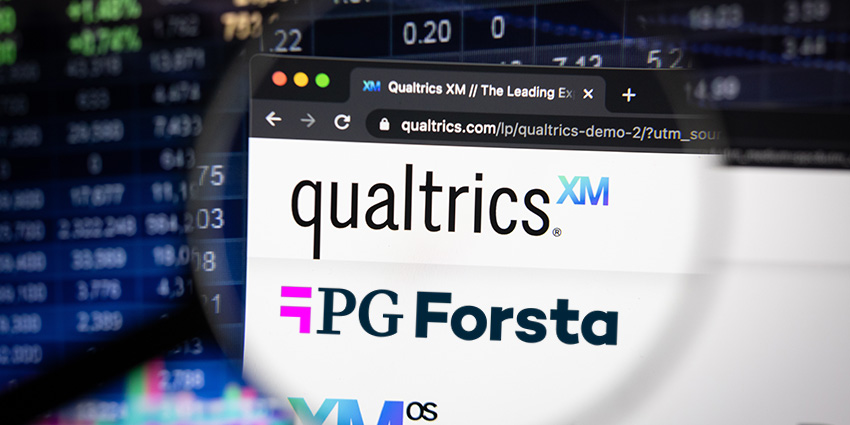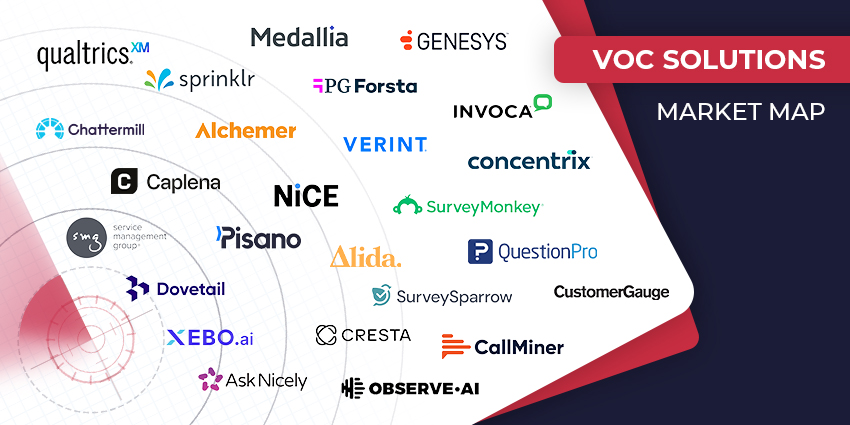In a repeat of last year, Qualtrics and Medallia lead the Gartner Magic Quadrant for VoC platforms 2025.
However, a new entrant joins them: Sprinklr. It shoots into the top-right quadrant, alongside InMoment and Forsta.
Other vendors making a first appearance in the report include SMG and XEBO.ai. Both slot into the niche player quadrant.
There, the VoC providers have company. Indeed, Pisano, Concentrix, and Verint also sit in the bottom-left quadrant.
In 2024, Verint and Concentrix accepted challenger and visionary positions, respectively.
Alchemer, however, escapes the niche player category and places as a challenger this time around.
Alida has dropped out of the report altogether. Meanwhile, several prominent VoC players – including NICE and SurveyMonkey – don’t feature.
The Definition of a Voice of the Customer (VoC) Platform
A voice of the customer (VoC) platform gathers customer feedback from various sources, runs analysis, and converts it into actionable insights.
Most think of customer surveys here. Yet, modern platforms collect VoC data from customer interactions, social media, third-party review sites, and beyond.
Then, utilizing AI analytics, they’ll uncover hidden customer preferences, motivations, and objectives.
From there, a VoC platform can guide customer-facing functions with recommended actions and prescriptive guidance.
CX leaders may also spread key insights to product teams, IT, and numerous other enterprise departments that may benefit.
Gartner highlights key platform features in its report. It then splits 12 VoC providers into the categories: leaders, challengers, visionaries, and niche players. Here’s how they performed.
Gartner Magic Quadrant Leaders
Leaders in the Magic Quadrant pair “solid” business results with a vision they execute via a forward-thinking product strategy and deep support services. They can also demonstrate success across customer segments and industries. This year’s leaders are:
- Qualtrics
- Medallia
- Sprinklr
- Forsta
- InMoment
Qualtrics
Qualtrics wins plaudits from Gartner for its “robust product offering”, enabled by a rapid innovation cycle. Exemplifying this, the vendor unveiled new AI agents, market research capabilities, and an innovative Location Experience Hub during its Qualtrics X4 2025 event.
Gartner also pinpoints its “strong” sector focus and “good market responsiveness” as core strengths. Again, the agentic AI offerings Qualtrics has already brought to market exemplify the latter.
Yet, one other strength – which Gartner neglects to mention – is its commitment to original innovation. Qualtrics’ rage click detection and Text iQ functionality are excellent examples of this.
Medallia
Medallia also earns credit for its “robust” platform and focused AI capabilities. Its sophisticated cohort tracking feature is an excellent example. It lets customers develop dynamic segments based on attributes, behaviors, and experiences. Ultimately, that supports scalable personalization.
Additionally, Gartner commends Medallia’s “clear understanding of client needs” and “strong geographic strategy”.
However, the analyst overlooks several other key strengths, like its data consolidation expertise – where it competes with CRM and CDP vendors to centralize customer interaction details. That allows Medallia to draw new insights from the VoC data it collects.
Moreover, Medallia has invested massively in converting insight into action. Consider its proactive tools for routing issues to the appropriate department, reaching out to a dissatisfied customer, and sharing coaching advice with reps. These are differentiative.
Sprinklr
In 2024, Sprinklr launched Sprinklr Surveys (now Sprinklr Customer Feedback Management), qualifying it for the Magic Quadrant. The solution joins an ecosystem that includes social media management, CCaaS, and conversational AI.
Sprinklr wants to – in the words of its new CEO, Rory Read – further “knit these solutions together” to provide differentiated innovation. As such, it’s a logical VoC choice for businesses already leveraging other elements of its portfolio.
While Gartner doesn’t recognize this ecosystem as a strength, it somewhat acknowledges this when applauding Sprinklr’s “well-designed” and “comprehensive” platform.
The analyst also underlines additional strengths, including its “strong sales-cycle support” and “robust training and customer community”.
Forsta
Forsta – under the name “Press Ganey Forsta” in the report – wins credit for its expertise in highly regulated industries. It exemplifies this in its sector-specific journey visualizations and templates, which simplify feature adoption.
Gartner also spotlights its “value-based sales strategy” and “good product enterprise support” as central strengths. Again, the latter exemplifies how Forsta is adept at solving complexity for its customers, with the ability to assign roles to specific users across hierarchies.
Other strengths not mentioned by Gartner are its visually compelling interface and differentiative features to solicit feedback from the frontline. The latter results from an acquisition strategy that has significantly boosted its market presence.
InMoment
In 2023, InMoment was the first VoC provider to pull generative AI into its platform. That innovation allowed customers to summarize groups of customer comments into concise overviews. Since then, it has rapidly expanded its AI-derived insight capabilities.
Gartner acknowledges this, lauding its “strong” ability to scour datasets – across numerous formats – to make predictions and recommend action.
Yet, it’s not just AI insight where InMoment proved quick to act. Indeed, it jumped on the agentic AI bandwagon early, releasing Active Listening Agents in October 2024.
While the analyst didn’t acknowledge this, it did commend the “short onboarding” experience that InMoment offers, alongside its “robust geographic strategy”.
Gartner Magic Quadrant Challengers
Challengers in the Magic Quadrant have the adequate size, platform depth, and support system to compete globally and across verticals. However, they lack the “compelling vision” of leaders for the VoC market of tomorrow. This year’s challengers are:
- Alchemer
Alchemer
Alchemer draws praise for offering “free proofs of concept (POCs)”, which it supports with a solution engineer to offer a “full experience” of the solution. Gartner also commends its “strong customer success management” and “easy-to-use” platform.
Another core strength that Gartner doesn’t note is in mobile app feedback capabilities, which it gained after acquiring Appentive in 2023. These are differentiative.
Nevertheless, the vendor lags due to its “lack of robust partner ecosystem” and “limited analytics and AI”. Although, in fairness to Alchemer, its collaboration with Chattermill has bolstered the latter with advanced text mining capabilities.
Gartner Magic Quadrant Visionaries
Visionaries in the Magic Quadrant deliver “potentially market-changing” innovations via their VoC platforms, which may shape the space’s future. Yet, they trail leaders in their track record for execution, size, and/or platform depth. This year’s challengers are:
- There are no visionaries in this year’s Magic Quadrant
Gartner Magic Quadrant Niche Players
Niche players in the Magic Quadrant may compete with leaders in a particular industry or geography. Nevertheless, size, geography, and overall product limitations limit their ability to execute on a broader scale. This year’s niche players are:
- Verint
- Concentrix
- Pisano
- SMG
- QuestionPro
- XEBO.ai
Verint
Verint draws praise for its “customer-service-driven CX”, with Gartner pointing to its portfolio of adjacent technologies. Those include its adjacent data hub, workforce engagement management (WEM) solutions, and conversational AI.
In many cases, it combines VoC with these applications to influence underlying customer service processes and agent experiences. For instance, a social post indicating negative sentiment could trigger an outbound, AI-led engagement. However, the possibilities extend further.
Gartner also applauds Verint’s “unique customer effort detection” and “strong data ingestion and mapping capabilities”. Yet, the analyst cautions against the vendor’s “limited customer journey analytics” and – as in 2024 – its “challenging user interface”.
Concentrix
Despite slipping into the niche player quadrant, Concentrix earns credit for its “effective marketing execution” and “strong overall viability”. Meanwhile, Gartner also mentions its “industry strategy” as a strength that helps shorten time to value.
Surprisingly, Gartner skips past Concentrix’s support services. Thanks to its BPO background, these transcend industry norms, with in-house teams running VoC programs for customers. Its hybrid mining capability is also a notable strength that goes unrecognized.
However, Garner warns that Concentrix lacks a “robust partner ecosystem” and cautions about its “limited marketing strategy”. Although, the latter is somewhat of a contradiction to its “effective marketing execution” strength noted earlier in the report.
Pisano
Pisano may lack brand recognition, but it makes up for this with “strong customer retention”, arranging intimate events to connect customers and build relationships. Its platform is also “easy to use” and features a “helpful AI assistant”, which Gartner tags as central strengths.
Another that flies under the radar is its low pricing. Across the VoC cycle of data gathering, analyzing, and actioning, Pisano comes at a lower cost than most other vendors in the Magic Quadrant – especially for its core data collection functionalities.
Yet, while its price point may be low, Gartner points to “lagging innovation” as a concern, alongside its lack of “strong professional services” and “no hands-on POCs”.
SMG
SMG draws acclaim for its “strong digital capability”, which links online customer experience feedback to product adoption. The study also lauds its “effective voice of the employee capability” and “good market understanding and execution”.
Its advanced mobile app, benchmarking tool, and intuitive report-building functionality are additional strengths that Gartner overlooks in the study.
The analyst does, however, caution as to SMG’s “limited direct sales strategy” and “services-heavy model”, which can hamper speed to deployment and agility thereafter.
QuestionPro
Like Pisano, QuestionPro stands out for its “low-cost solution”. Its “go-to-market strategy” that targets small and medium-sized enterprises and “simplified product for early-stage CX” also won Gartner’s approval.
Another possible strength the analyst could have noted is QuestionPro’s focus on matching feedback to specific customer touchpoints, so customers can monitor the moments that matter most.
In terms of critique, Gartner warns of “limited AI capabilities” and “limited large-enterprise support” – although, as QuestionPro targets the lower end of the market, these snags are understandable.
XEBO.ai
New entrant XEBO.ai is a surprise addition to the Magic Quadrant, ahead of much more established VoC players, with deeper offerings.
Nevertheless, Gartner validates its pick by pointing to its “support for indirect customer feedback”, praising the provider’s social listening capabilities. The analyst also applauds XEBO.ai for its “effective sales strategy” and “available international support”.
However, despite a “compelling roadmap”, Gartner warns of limited innovation and believes XEBO.ai could do more to inspire continuous community engagement.
For further Gartner Magic Quadrant coverage, read the rundowns:
- Gartner Magic Quadrant for Contact Center as a Service (CCaaS) 2024
- Gartner Magic Quadrant for CRM Customer Engagement Center (CEC) 2024
- Gartner Magic Quadrant for Digital Experience Platforms 2025







